This post is a reprinting of a post on a forum that is frequented by Billax. Billax is not only one of my style role models, but a friend and a man that was Trad back when it was called Ivy League.
A few days ago, I responded to a member of the Talk Ivy forum, who asked about the details he should seek in a pair of trousers. I 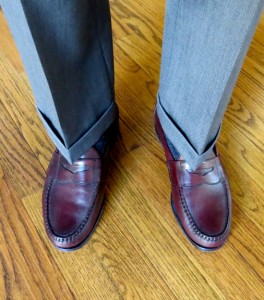 thought I’d cross-post it here,
thought I’d cross-post it here,
I’m on a fairly steep learning curve regarding the finer details of Ivy garb and am struggling to find information regarding trousers (of the slightly more formal variety such as flannels, tweeds, gabardines etc. as opposed to khakis or jeans).
Thanks.
The poster continued, noting that he knew flat front trousers were a requirement, then asked for the next most important feature. I responded as follows:
A friend, who is an Architecture Professor, asserted that the most important class he taught to Architecture students was Joints, Intersections, and Edges. When things go awry in those areas, the building fails – both functionally and aesthetically. In mens apparel, the two areas most likely to fail are at the top and at the bottom.
I believe the importance of joints, intersections, and edges at the top is pretty well understood: the importance of the relationships between shirt, tie, jacket, lapel, notch shape, gorge height, and collar roll is a focal point of men who care about their appearance. It is, after all, what they see in the mirror every morning.
Not one man in a thousand has a mirror to see the equally important bottom of one’s outfit. Yet, those bottom elements – trouser length, crease, cuff, socks, and shoes – are easily seen by everyone who looks at you. It’s often said – and it’s true for me – that when one business or professional man is introduced to another, the first thing looked at is the other man’s shoes. Style, condition, edge dressed, polished – check, check, check, check. But if the joints, intersections, and edges of the bottom aren’t “right,” well, that’s noted and filed away. In the Ivy League Look, the gold standard has remained unchanged for a long, long time. To wit:
In 1954, Life Magazine had an article about the Ivy League Look sweeping the country. The following photograph appeared therein:
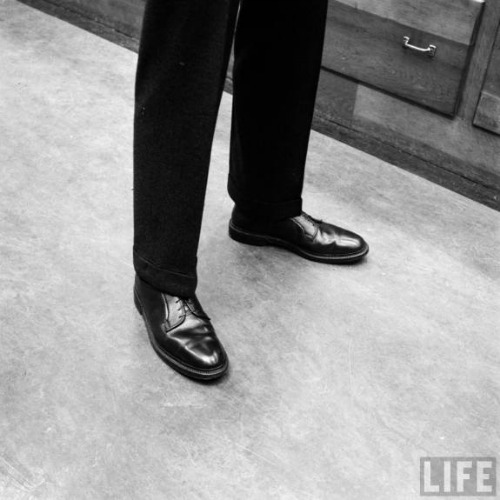 This picture is of a Salesman at J. Press New Haven.
This picture is of a Salesman at J. Press New Haven.
When I went to college (Fall of 1959 to Winter of 1964), I was lucky enough to work part-time in the Campus Ivy shop at my Midwestern University. Mr. Ross, the proprietor, was as fastidious a dresser as I’ve ever met – and he wanted me to represent the same style and values he had. Though I didn’t wear braces –then or now – when he saw me come in to work, he’d give me a once over, particularly checking to see that I had no break in my trousers. If he spotted anything other than a knife blade crease, he’d gently say, “Adjust your braces, Bill,” knowing full well I wore a belt. I must have disappointed him one time too many, for he once said to me, “It is better to endure the occasional flood than to live in a perpetual puddle.” It was then that I took the words of this diminutive and dapper Scotsman to heart!
A little more than a year ago, my youngest son entered college. I went with him for a couple of days to help him move into his dorm and to buy him a few items of clothing I thought he was missing. We stopped at J. Press, where Tony, the alterations tailor who has worked there since 1968, fitted him for a couple of pairs of trousers. As he bent down to chalk the hems, he asked, “Cuff, no break?” While posed as a question, it was really a suggestion. I smiled slightly, then nodded. The words were so familiar, it seemed as though I was back in college.
So, for sixty years now, there has been a set of men who are keepers of that flame. I am content to live in the flickering light of that flame. Plenty of others will disagree….
Thanks for asking!
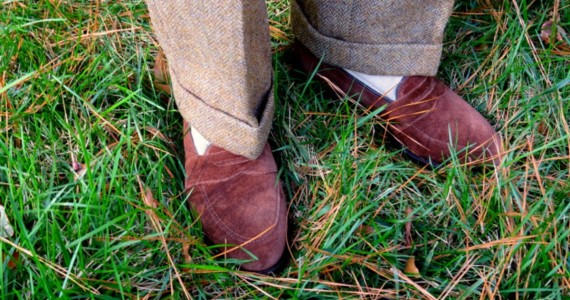
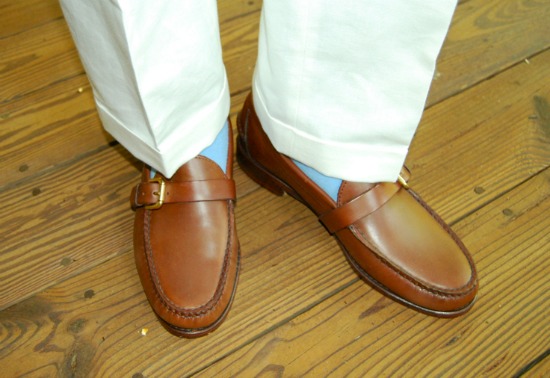
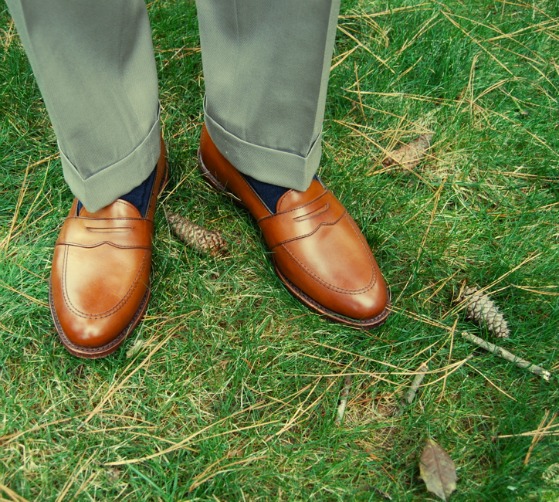

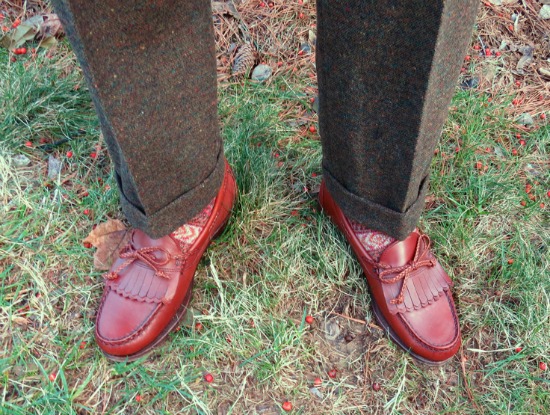
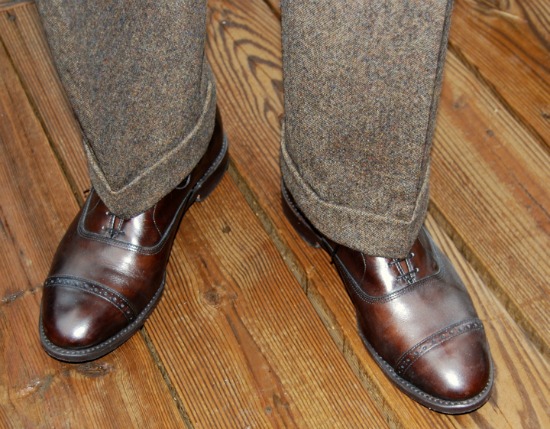
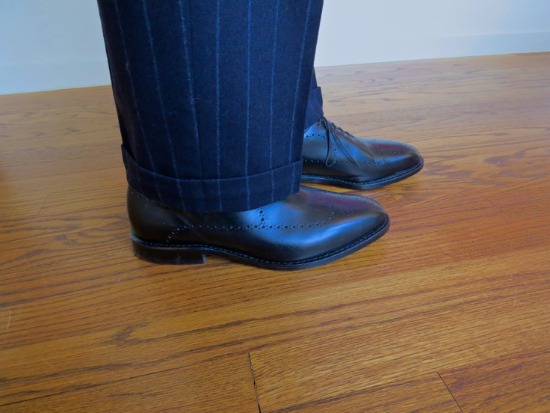

awesome pin stripes pants…
Jerrod,
I love the style of both you and Billax, except for three things:
1. No pocket squares.
2. Short pants.
3. Skimpy cuffs.
I realize that I’m unlikely to change your mind on pants length. But, for other readers of your blog who agree with me and are looking for an alternative length, I like Luciano Barbera’s “mid-atlantic” break (so named because it’s a compromise between Europeans — who apparently tend to wear their pants more like you two, and Americans — who definitely tend to wear their pants way too long):
http://media.tumblr.com/tumblr_li2b5nLNvm1qfex1b.jpg
To me, the ideal is the length on his left leg; the right looks a little too long, I guess because of how he’s standing. A good rule of thumb for this look is a slight break, long enough to cover the socks when walking, but not long enough to puddle.
Regarding cuffs, Maxminimus preaches 2″ cuffs. I had a suit finished that way last year for the first time, and I don’t think I’ll ever go back. Like I said, I’m sure I’m not going to change your mind on break, but I strongly urge you to consider 1 3/4″ or even 2″ cuffs. If you really hate them, you can always have them redone. These skimpy cuffs remind me of the cuffs that come on the factory inseam on cheap pants.
Thanks for the great blog.
Cheers.
I used to not believe in the idea of a “sartorial icon”, but Billax is absolutely one of them for me. No one I’ve seen blends comfort with style to such a degree. Such a gentleman.
Perhaps this was more obvious to others, but I have found through my own experience what really makes or breaks (no pun intended) the “cuff, no break” look is how wide the leg opening is at the bottom of the pants. If the opening is too large, the proportions really get thrown off (which I would venture to say is what’s happening in the image above with the pinstripes and wholecuts).
You make an interesting point, Trip. For dress suits (city rather than country suits) I use an 18″ leg opening, so as to cover the laces of Balmorals and Bluchers (and in the case you mention, Wholecuts). All others are narrower, with madras, poplins, chinos, and khakis having the narrowest leg opening, at 15-16″. For country suits and odd trousers, my leg opening is tapered to 16-17″.
I think the opening/break on those two middle tweed trousers is spot on. They look great.
“Billax is the master of the “cuff, no break” I’ve been dressing Ivy League/Trad for 50 years but it’s only since I have seen Billax’ example that I have been inspired to get the no break just right.
2″ cuff no break. Wore it in the 60’s still wearing it today.
-CS
Billax is our guiding light.
They’re a tad short for my liking, but you guys wear it as well as anyone can.
For me, too, the trousers are just a tad short, but I also heartily concur that Billax looks great! I love the combination of colors and textures, and the last picture? Perfection. Billax is a man of impeccable style and taste.